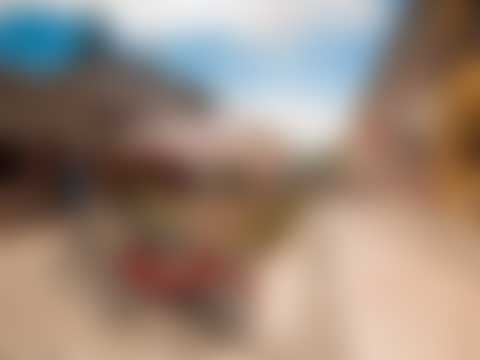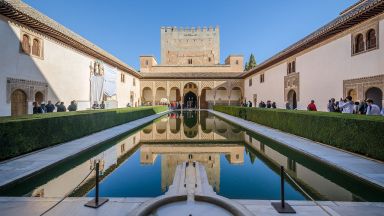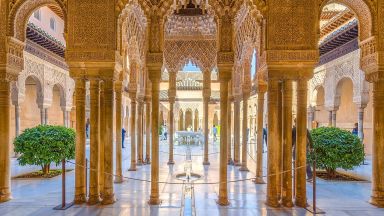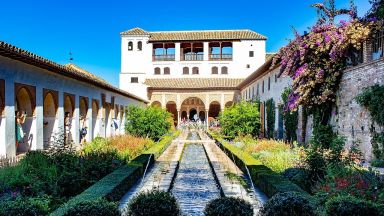Monasterio de la Cartuja was formerly a Roman cemetery. In 1506 the Great Captain donated land to the monks so that they could build the Monastery. The building of the monastery began ten years later in 1516, under architect Don Gonzalo Fernandez of Córdoba. Construction began in 1516 and continued for the next three hundred years but the project was never completed. Eventually, lands were confiscated from the monks in 1836 and the cloister and the cells were destroyed in 1842 and the Prior’s House in 1943. Sadly in the years since their departure, the great cloister has been lost, along with the monks’ cells – a result of the Napoleonic war, and a lack of overall preservation.
The Cartuja monastery was inhabited by the Carthusians. The Carthusians was originally a French order and the french for Carthusian is Chartreuse. The monks lived as hermits in the monastery following very strict teachings. The order was founded by Saint Bruno in France in the 11th century. They spent most of their time praying and they had taken strict vows of silence and fasting, and they lived in confined cells. There were 24 Carthusian monasteries in Spain, but most were closed in 1836 with the general excommunication – now only four remain inhabited: Miraflores in Burgos, Montealegre near Barcelona, Aula Dei in Zaragoza, and Porta Coeli near Valencia.
The monastery was also home to laymen who also lived under a vow of silence. While the laymen were allowed to leave the cloister once a week, the monks only left three or four times a year. Following a simple diet, they didn’t eat meat and on Fridays they would only eat bread and water. Most of their meals would be eaten in their rooms, but on Sundays and Holy Days they would eat in the refectory.
Tours in and around the Monastery of Cartuja
There are only a few guided tours that include a visit to the Corral del Carbón and the area around it. We have listed them here.
What to see at the Monastery of Cartuja
You can enter the Cartuja Monastery through a simple patio with arches. Inside the monastery you will first see the Refectory and the Church.
Central cloister
When you enter the building, the first part you see is the central cloister containing a fountain and four large orange trees. To the right of the cloister there are three smaller chapels containing figures and statues; you cannot enter because they are no larger than cupboards, but you can see in; the décor and attention to detail in each of these are astonishing.
The Church
The Church has a single nave divided into three parts.
- Presbytery – The first near the entrance was for the for the public is the presbytery, which is the most elaborately decorated area of the monastery and is dominated by sculptures of the Carthusian Bishop, St John the Baptist, St Bruno. There are also four paintings by Sanchez Cotan, who was a pioneer of the realist style in Spain, detailing scenes of passion and, in the center, a piece by Bocanegra, La Asunción de Nuestra Señora – The Ascension of Our Lady.
- The Sancta Sanctorum – is the next section for the laymen, is separated from the main temple by a Venetian glass gate. The architecture, art and sculptures together make one of the most beautiful and interesting baroque works in all of Spain; the statues even appear to have real tears. It was created by Francisco Hurtado Izquierdo between 1704 and 1720. All of the austerity of the Carthusians changes here into magnificence, in honour of the Holy Eucharist. There are statues of St Mary Magdalene, St John the Baptist and St Bruno (again), surrounded by naked cherubs and angels. In the centre sits the tabernacle – a pedestal with four golden statues supported by eight black columns. Inside this tabernacle lies the Eucharist which the monks praised.
- The Sacristy for the monks is a dour, dark space. Also designed by Hurtado Izquierdo, between 1727 and 1764, it acts as a reminder of the austerity its former monks were committed to, in contrast to the extravagance that surrounds it.
The Refectory and the Sala de San Pedro y Pablo
The Refectory, or dining room is much larger than the other rooms, apart from the Church. There is a pulpit at one end where sermons would have been read during meal times, and a crucifix is painted on the wall. Joined to the refectory is the Sala de San Pedro y Pablo. It is a small room which used to have a fountain where the monks would wash before meal times, whilst reciting psalms.
The Old Chapel
The Old Chapel was built before the church´s construction.
The Sala Capitular
Next to the Old Chapel is the Sala Capitular, where the monks met to discuss the community’s issues. The large gate has a great bronze lock and key. This room follows the gothic trends of the rest of the monastery, and also now hosts the works of Sanchez Cotan and Carducho.
Nowadays the monastery appears more a museum for ecclesiastical art, as the majority of the rooms are not set out to their original purpose. However, the extravagant Baroque art and architecture in itself makes this building really worth a visit. Don’t miss the view from the top of the steps at the entrance: a spectacular panorama of the city, the university, the mountains, and beyond.
How to get to the Cartuja Monastery
The Cartuja Monastery is located on the outskirts of Granada, about three kilometers from the city centre.
It is best to take one of these city buses: N7, U1, U2, U3. The best stops are ‘Science Education’ or ‘Paseo de Cartuja’. For a taxi you will be charged about € 6 from the city centre.
The stop where to get off is either ‘Science Education’ or ‘Paseo de Cartuja’.
If you prefer to go by taxi, it will cost you about 6-8 euros from the centre.



